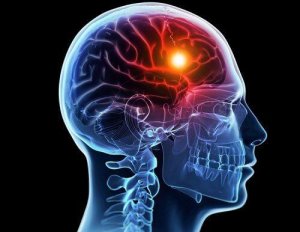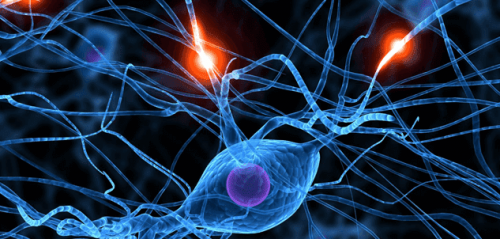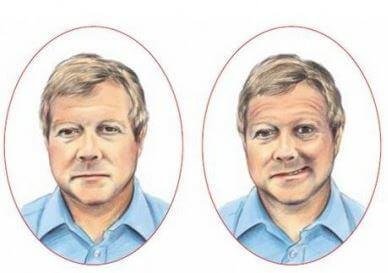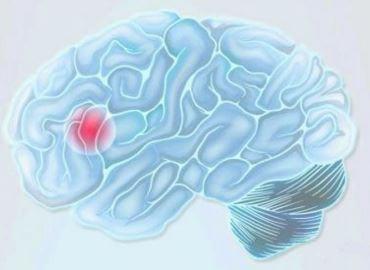Stroke: Causes and Types

A stroke is a type of cerebrovascular pathology. Strokes represent up to 50% of all neurological diseases. In addition, strokes are the third cause of death in the world after heart disease and cancer.
These neurological alterations caused by a pathological process of the blood vessels cause brain abnormalities. The brain depends on a steady blood flow. Therefore, brain damage occurs when blood flow stops in a certain region for as little as a few minutes. If this problem persists, neuronal necrosis continues and causes an irreversible lesion.
How to detect the damage of a cerebrovascular pathology?
On one hand, doctors and neurologists can use radiological tests to detect brain damage. For example, a CT scan or MRI scan can provide a lot of information about affected brain structures.
In addition, it’s important that a psychologist does a neurological examination. By doing this, you can find evidence that radiological tests can’t detect, such as changes in behavior. Both techniques are necessary for a more complete and rigorous diagnosis.

Characteristics of a stroke
A stroke is a type of cerebrovascular pathology. It forms from a group of heterogeneous disorders in which a vascular mechanism produces a brain injury. The prevalence of stroke has increased throughout recent decades due to increased use of neuroimaging techniques. These techniques have allowed us to increase our stroke detection. Lifestyle choices also increase the incidence of strokes.
The main risk factors of strokes are related to the processes that facilitate the accumulation of fats in blood vessels and their calcification or loss of flexibility. That is, hypertension, cholesterol, diabetes, or tobacco use. Suffering a stroke is more frequent after the age of 60. CVA causes the interruption of blood flow in one part of the brain. This lack of oxygen maintained over a period of time causes brain tissue damage or death.
How cerebrovascular accidents manifest
The symptoms of stroke are usually painless and transient, so they often go undiagnosed. However, their manifestation usually occurs on the opposite side of the body to the affected hemisphere. For example, if there’s decreased blood flow in the right side of the brain, the consequences will tend to manifest in the left half of the body.
In addition, there’s usually a loss of strength or numbness in one half of the body (face, arms, legs, etc.) A sudden loss of vision can also occur, either partial or total in one or both eyes. Difficulty to speak or understand is also common.

Types of stroke
A stroke produces a disruption of normal cerebral blood flow. This is what we call a cerebral infarction. Obstruction (ischemic stroke) or hemorrhage (hemorrhagic stroke) cause cerebral infarction. Let’s delve deeper into both types.
Ischemic stroke (obstructive)
The cause of an ischemic stroke is the interruption of blood flow due to a blockage of the blood vessel. A clot circulates through the blood vessel in the direction of the brain. It anchors at some point in an artery and causes an obstruction. When less blood is present in the brain, there’s also less oxygen. This causes damage in the area with insufficient blood flow.
The causes of this type of stroke are the lack of systemic irrigation, thrombosis, or embolism.
- Thrombosis: Originates when a blood clot superimposed on an atheroma (a layer of solidified fat) narrows the cerebral blood vessel. They can appear suddenly.
- Embolism: A clot, formed in the heart or as a fragment of a thrombus, is released into the bloodstream and blocks a distal artery.
Hemorrhagic stroke
The mortality rate of hemorrhagic strokes is higher than that of ischemic strokes. Approximately between 30 and 50 percent of those who suffer from hemorrhagic strokes die within the first months of suffering their hemorrhagic stroke.
Hemorrhagic strokes are more severe because spilled blood can also cause brain damage. In this case, the hemorrhage itself is a damaging factor. An artery becomes weak and ruptures, which causes the stroke. Aneurysms and hypertension are two mechanisms that can make a vessel rupture.
- Aneurysm: An aneurysm is the dilation, widening, and localized bulging of a blood vessel. It’s a result of congenital weakness in the artery wall. As a consequence, the blood begins to fill the subarachnoid space. The skull can’t alter its volume to accommodate this new blood, and intracranial pressure increases. It produces serious side effects.
- Hypertension: Hypertension increases the risk of intracerebral hemorrhage. In this case, blood is released into the brain and begins to damage different areas. The likelihood of dying from hypertension is 80%. There’s a high risk of ending up in a vegetative state.

The prevalence of cerebrovascular accidents is currently 3.5% of the population over 64 years of age. From 65 to 74 years, there’s a greater chance of stroke in men. However, after the age of 75, the risk increases significantly amongst females.
Bibliography
Junqué, C. and Barroso, J. (2009). Neuropsychology Manual. Madrid: Editorial Síntesis.
A stroke is a type of cerebrovascular pathology. Strokes represent up to 50% of all neurological diseases. In addition, strokes are the third cause of death in the world after heart disease and cancer.
These neurological alterations caused by a pathological process of the blood vessels cause brain abnormalities. The brain depends on a steady blood flow. Therefore, brain damage occurs when blood flow stops in a certain region for as little as a few minutes. If this problem persists, neuronal necrosis continues and causes an irreversible lesion.
How to detect the damage of a cerebrovascular pathology?
On one hand, doctors and neurologists can use radiological tests to detect brain damage. For example, a CT scan or MRI scan can provide a lot of information about affected brain structures.
In addition, it’s important that a psychologist does a neurological examination. By doing this, you can find evidence that radiological tests can’t detect, such as changes in behavior. Both techniques are necessary for a more complete and rigorous diagnosis.

Characteristics of a stroke
A stroke is a type of cerebrovascular pathology. It forms from a group of heterogeneous disorders in which a vascular mechanism produces a brain injury. The prevalence of stroke has increased throughout recent decades due to increased use of neuroimaging techniques. These techniques have allowed us to increase our stroke detection. Lifestyle choices also increase the incidence of strokes.
The main risk factors of strokes are related to the processes that facilitate the accumulation of fats in blood vessels and their calcification or loss of flexibility. That is, hypertension, cholesterol, diabetes, or tobacco use. Suffering a stroke is more frequent after the age of 60. CVA causes the interruption of blood flow in one part of the brain. This lack of oxygen maintained over a period of time causes brain tissue damage or death.
How cerebrovascular accidents manifest
The symptoms of stroke are usually painless and transient, so they often go undiagnosed. However, their manifestation usually occurs on the opposite side of the body to the affected hemisphere. For example, if there’s decreased blood flow in the right side of the brain, the consequences will tend to manifest in the left half of the body.
In addition, there’s usually a loss of strength or numbness in one half of the body (face, arms, legs, etc.) A sudden loss of vision can also occur, either partial or total in one or both eyes. Difficulty to speak or understand is also common.

Types of stroke
A stroke produces a disruption of normal cerebral blood flow. This is what we call a cerebral infarction. Obstruction (ischemic stroke) or hemorrhage (hemorrhagic stroke) cause cerebral infarction. Let’s delve deeper into both types.
Ischemic stroke (obstructive)
The cause of an ischemic stroke is the interruption of blood flow due to a blockage of the blood vessel. A clot circulates through the blood vessel in the direction of the brain. It anchors at some point in an artery and causes an obstruction. When less blood is present in the brain, there’s also less oxygen. This causes damage in the area with insufficient blood flow.
The causes of this type of stroke are the lack of systemic irrigation, thrombosis, or embolism.
- Thrombosis: Originates when a blood clot superimposed on an atheroma (a layer of solidified fat) narrows the cerebral blood vessel. They can appear suddenly.
- Embolism: A clot, formed in the heart or as a fragment of a thrombus, is released into the bloodstream and blocks a distal artery.
Hemorrhagic stroke
The mortality rate of hemorrhagic strokes is higher than that of ischemic strokes. Approximately between 30 and 50 percent of those who suffer from hemorrhagic strokes die within the first months of suffering their hemorrhagic stroke.
Hemorrhagic strokes are more severe because spilled blood can also cause brain damage. In this case, the hemorrhage itself is a damaging factor. An artery becomes weak and ruptures, which causes the stroke. Aneurysms and hypertension are two mechanisms that can make a vessel rupture.
- Aneurysm: An aneurysm is the dilation, widening, and localized bulging of a blood vessel. It’s a result of congenital weakness in the artery wall. As a consequence, the blood begins to fill the subarachnoid space. The skull can’t alter its volume to accommodate this new blood, and intracranial pressure increases. It produces serious side effects.
- Hypertension: Hypertension increases the risk of intracerebral hemorrhage. In this case, blood is released into the brain and begins to damage different areas. The likelihood of dying from hypertension is 80%. There’s a high risk of ending up in a vegetative state.

The prevalence of cerebrovascular accidents is currently 3.5% of the population over 64 years of age. From 65 to 74 years, there’s a greater chance of stroke in men. However, after the age of 75, the risk increases significantly amongst females.
Bibliography
Junqué, C. and Barroso, J. (2009). Neuropsychology Manual. Madrid: Editorial Síntesis.
This text is provided for informational purposes only and does not replace consultation with a professional. If in doubt, consult your specialist.







